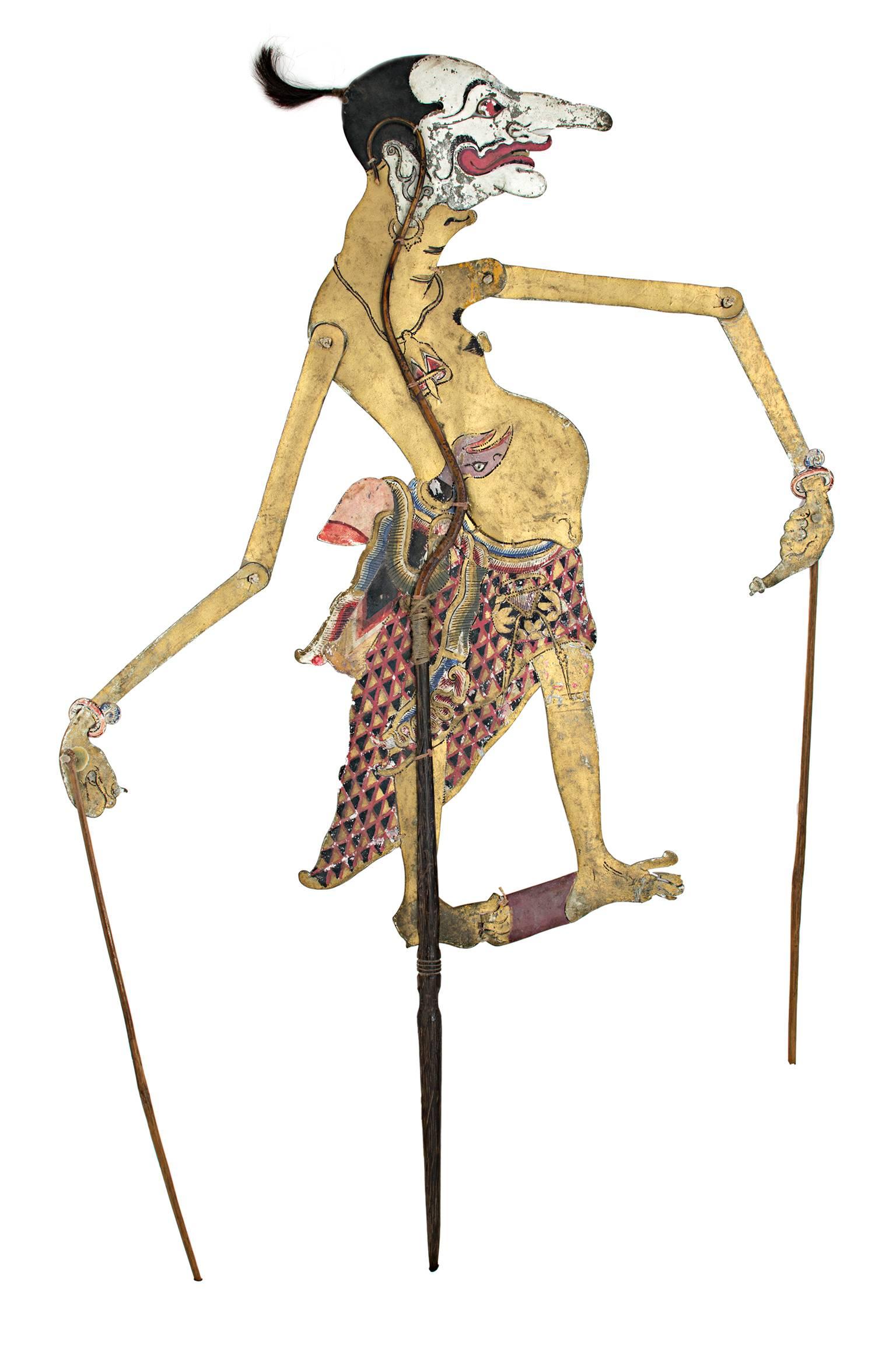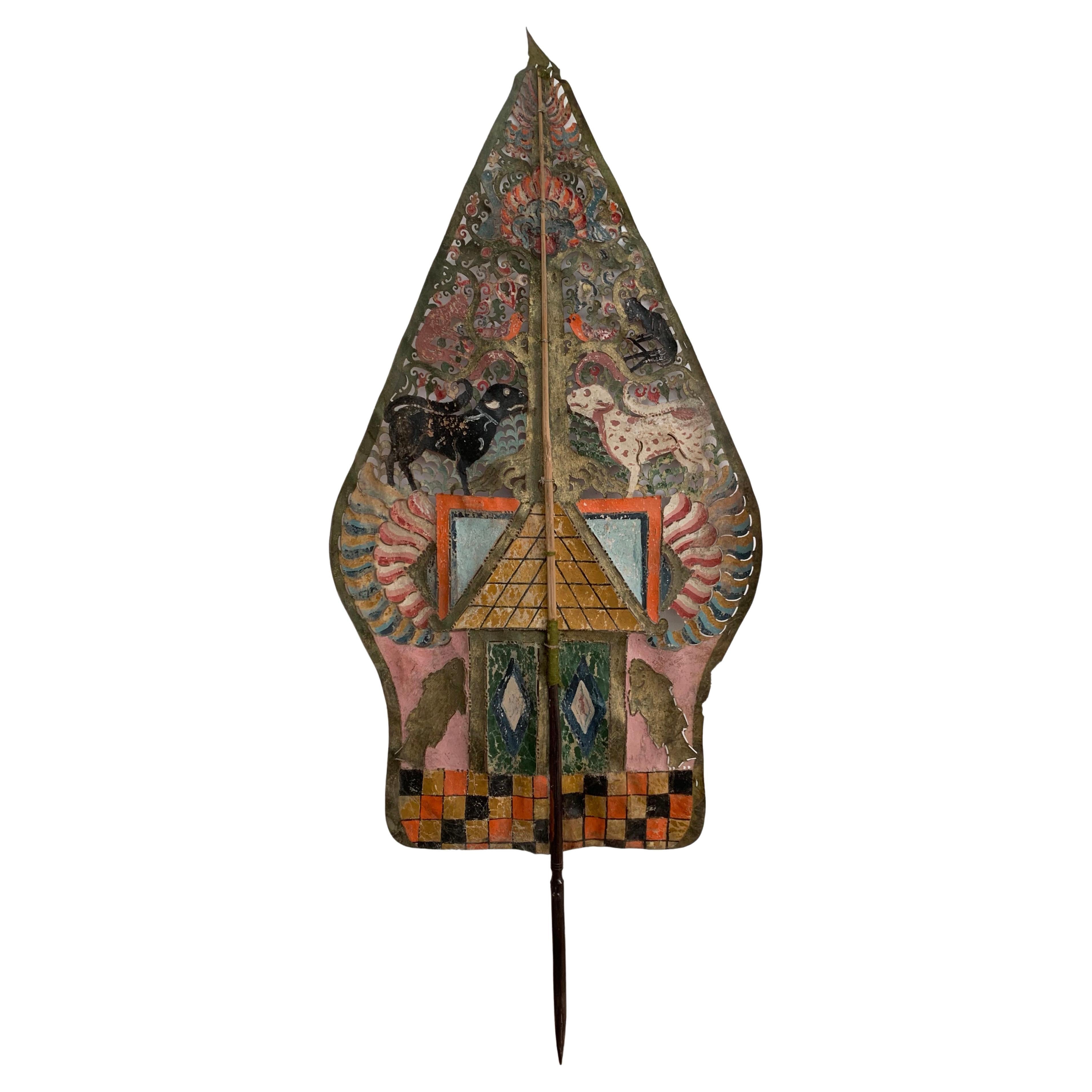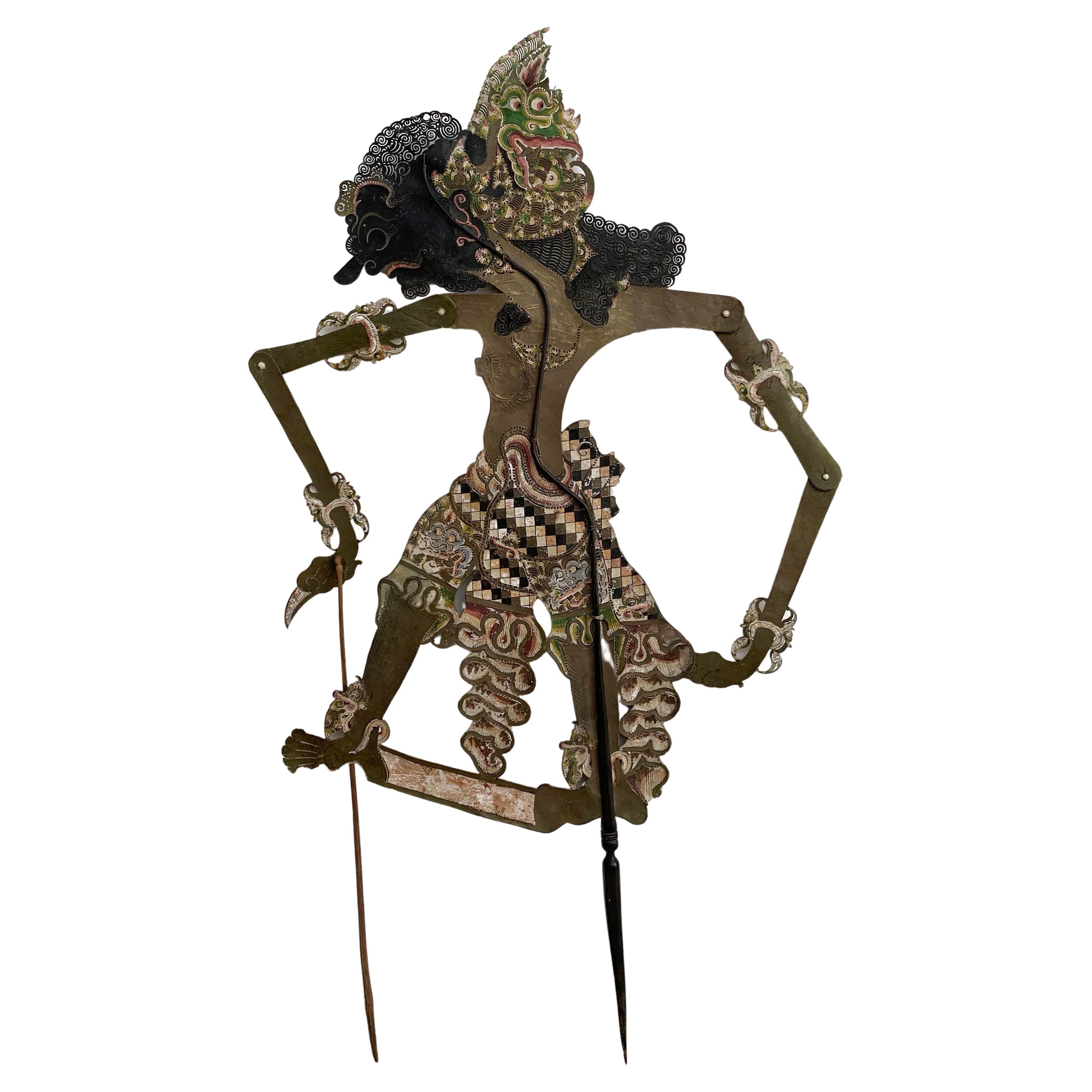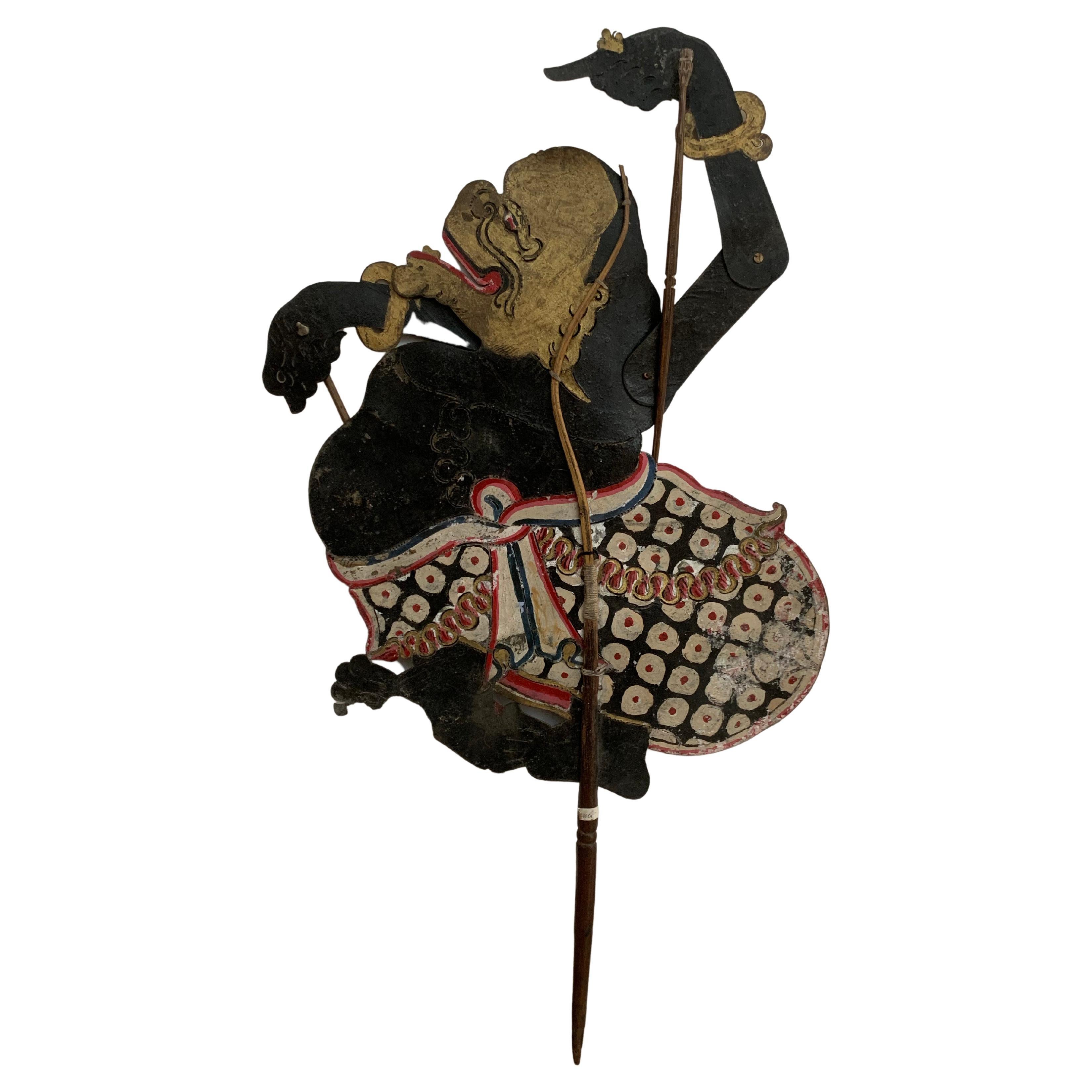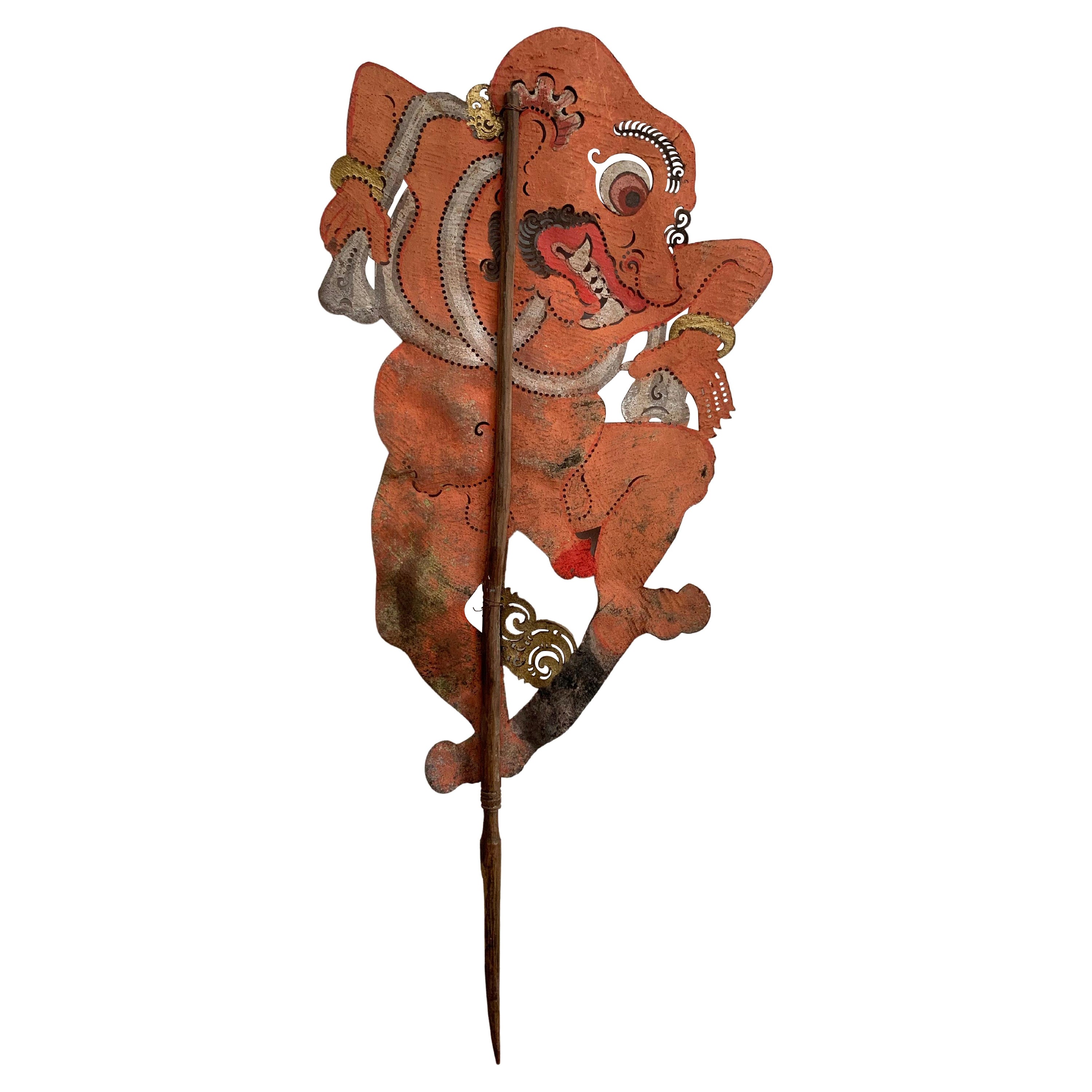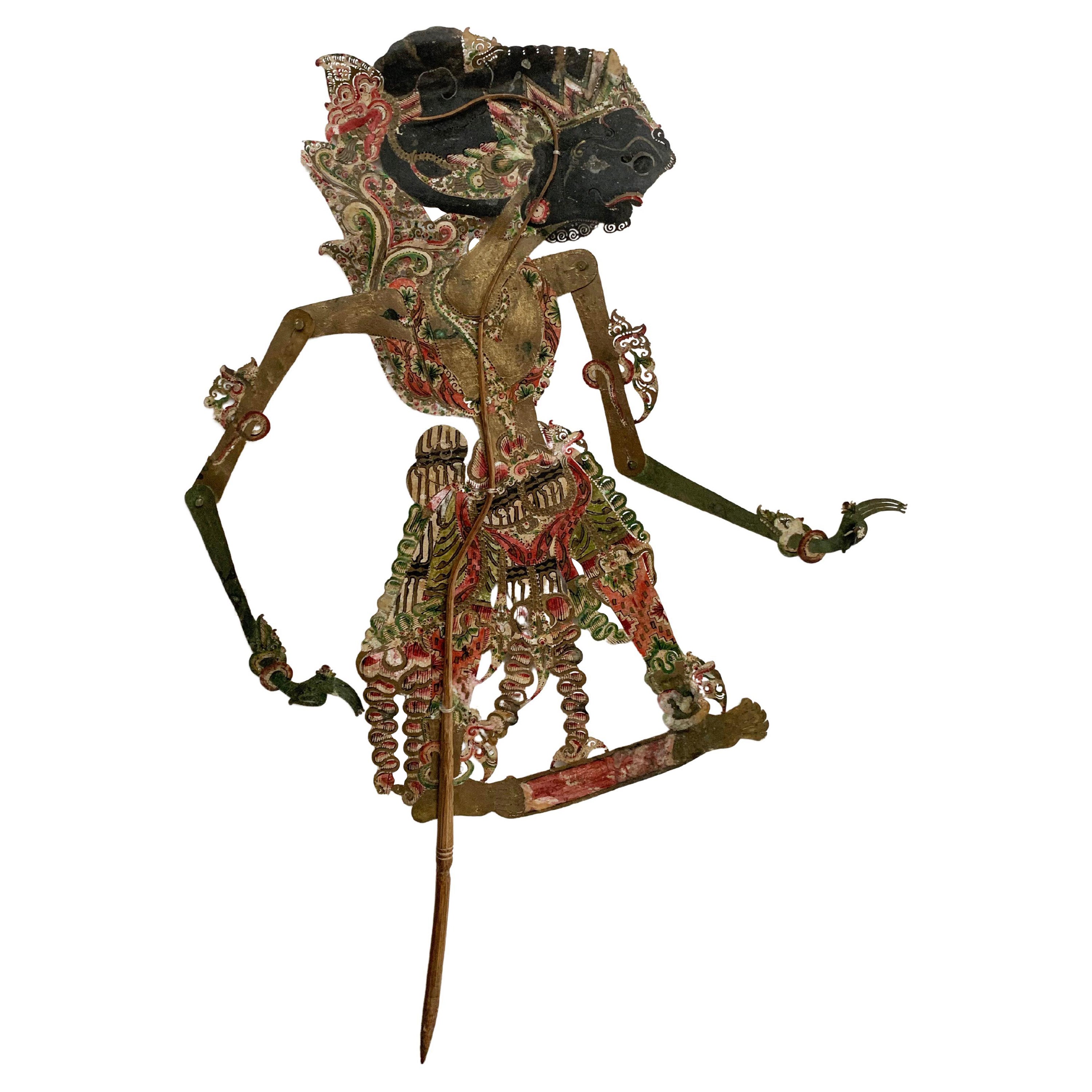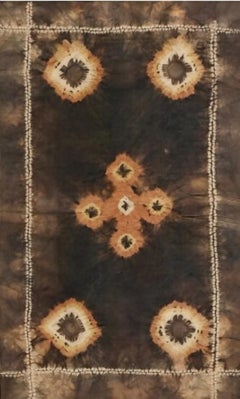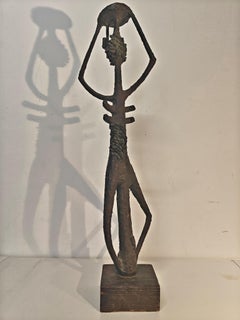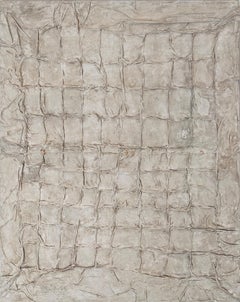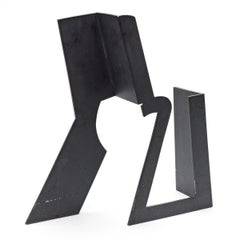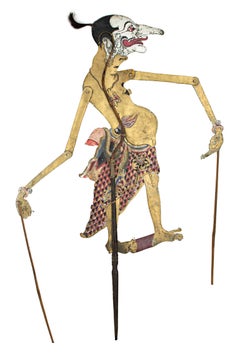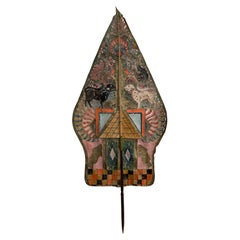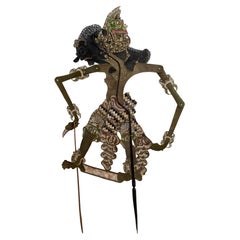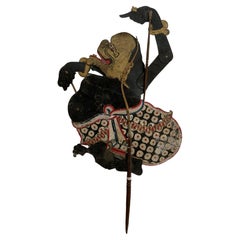Items Similar to Antique Thai Shadow Puppet, Buffalo Hide, Nang Yai
Want more images or videos?
Request additional images or videos from the seller
1 of 4
UnknownAntique Thai Shadow Puppet, Buffalo Hide, Nang Yai
$1,200
$3,00060% Off
£903.24
£2,258.1060% Off
€1,038.88
€2,597.2060% Off
CA$1,688.49
CA$4,221.2260% Off
A$1,851.13
A$4,627.8360% Off
CHF 970.15
CHF 2,425.3760% Off
MX$22,480.03
MX$56,200.0860% Off
NOK 12,103.80
NOK 30,259.5060% Off
SEK 11,454.61
SEK 28,636.5160% Off
DKK 7,753.96
DKK 19,384.9160% Off
About the Item
Antique Thai Shadow Puppet. Puppet is hand carved and constructed of buffalo hide. Overall measures 40 x 22 inches. Framed dimensions are 50 x 34 3/4 inches.
Provenance:
Private Collection, Atlanta, Georgia
One of the oldest forms of theater is Thai Shadow Puppets, which dates back as early as 400 B.C.. Originally, this art derived from India, then through to Thailand. In Thai culture, the tradition is telling stories through the use of a shadow puppet. The performance, the story, and the puppets used vary among different region in Thailand.
Initially, the appearance of the Thai shadow puppets tend to be flat, and handmade to leather. The puppet is made with the skin of the cow, or water buffalo. The skin is placed in water to soften the material, then pounded until the skin is semi-transparent. In order for the artists to carve and paint the leather to create the characters in the play, all of the steps in making it must be done. The art called “nang,” translates to hide.
To showcase the performances, a puppeteer must be placed behind a white, thin sheet, with a light shining from behind. This projects a shadow of the puppet cut out that the audience can see. Prior to the use of the electric light bulb, puppeteers used oil lamps. Bringing the puppet to life requires the use of wooden or bamboo sticks to control the puppet’s movements, such as walking, dancing, or even speaking. Not only does the puppeteer have to monitor the puppets actions, they must narrate the story from behind the white screen, and create a voice for each of the different characters used. Occasionally, another individual or group may play musical instruments to add excitement and pleasure to the performance.
The art of Thai shadow puppets is not only to manipulate the figures, but to portray an abundant repertoire of stories. During the performance, puppeteers do not use a script. The puppeteers rely solely on their memory, while improvising. Thai shadow puppetry has been commercialized for entertainment, and created for the tourist, while promoting cultural heritage. Thai shadow puppets tradition is reciting the stories of gods and humans through love and current events. (Miller).
The Nang is classified into two groups. One is called Nang Talung, whereas the other is Nang Yai. Nang Talung uses leather puppets which have movable limbs controlled by a string. Another grander version of the shadow puppet art is called Nang Yai, which means big hide, so the shadow puppets are more life sized. Both styles and themes are relatively similar. These two types of Nang are presented to the Thai society, while being universally acknowledged throughout Thailand. Nang performances themes include adventures of a wanderer, romance like star crossed lovers, masters teaching magic to their apprentice, family conflict, or abandoned children who seek to find their loved ones. The Nang pursue to pass on to the audience the significance of Thai ideologies and values. Last remnants of the Thai tradition and shadow puppets is the Nang.
The presenters and teachers of the type of Thai shadow puppetry, Nang Talung are known as Nai Nang. There are over 300 in the South of Thailand. The Nai Nang must have a range of story lines and techniques, and incorporate it into the Thai shadow puppet characters. By doing this, it will ensure that the fluidity and rhythm of the performance maintains the audience’s interest. Nai Nang are highly respected and intertwined into the Thai cultural fibers. Although the Nang was based on Buddhist ideology and philosophy, they also incorporated Hindu iconography and characters.
Thai shadow puppets theatre is for audiences of all ages, not just the younger generation. The tradition of shadow puppets exist throughout Asia, not just Thailand; however, the main focus was Thai culture. The shadow puppets create a sense of divine inspiration, as well as mystery. These shadows are considered sacred. They have roots in religious observances, embodying Brahmanism, Hinduism, Buddhism, and ancestral worshipping. “The art of the puppeteer developed from ancient animalistic beliefs whereby every object, animate or inanimate, has a soul.” The puppets, in all cultures, are treated with respect. They are revered as vessel of living energy. Preceding each performance is both prayers and offerings, where the puppet master requests for protection and blessings.
Many of the Thai shadow puppet performances have a consistent religious theme. The reenactments in the performances have an episodes of the Hindu epics, Ramayana. The Ramayana epic contains a variety of individual stories. The shadow puppet represent social organization and hierarchy. In addition, it represents harmony, while signifying the universe, and symbolizing the difficulties faced in harmony and chaos, the good and the evil, and endeavor to reach a balance.
- Dimensions:Height: 50 in (127 cm)Width: 34.75 in (88.27 cm)
- Medium:
- Period:
- Condition:Excellent.
- Gallery Location:New York, NY
- Reference Number:1stDibs: LU184129905202
About the Seller
5.0
Platinum Seller
Premium sellers with a 4.7+ rating and 24-hour response times
Established in 2022
1stDibs seller since 2022
122 sales on 1stDibs
Typical response time: <1 hour
- ShippingRetrieving quote...Shipping from: Saratoga Springs, NY
- Return Policy
Authenticity Guarantee
In the unlikely event there’s an issue with an item’s authenticity, contact us within 1 year for a full refund. DetailsMoney-Back Guarantee
If your item is not as described, is damaged in transit, or does not arrive, contact us within 7 days for a full refund. Details24-Hour Cancellation
You have a 24-hour grace period in which to reconsider your purchase, with no questions asked.Vetted Professional Sellers
Our world-class sellers must adhere to strict standards for service and quality, maintaining the integrity of our listings.Price-Match Guarantee
If you find that a seller listed the same item for a lower price elsewhere, we’ll match it.Trusted Global Delivery
Our best-in-class carrier network provides specialized shipping options worldwide, including custom delivery.More From This Seller
View All"Halloween" Blanche Lazzell, Batik Abstract Textile Composition, Cloth Dyeing
By Blanche Lazzell
Located in New York, NY
Blanche Lazzell
Halloween, circa 1920-22
Batik
15 1/2 x 9 inches
Provenance:
The artist
James & Janet Reed (gifted from the above)
John Cuthbert, Morgantown, West Virginia
Born ne...
Category
1920s Abstract Mixed Media
Materials
Textile, Dye
"Untitled" David Hare, Surrealist, Anthropomorphic, Modernist, Ab-Ex Sculpture
By David Hare
Located in New York, NY
David Hare
Untitled, circa 1949
Bronze
25 x 8 x 7 inches
Provenance
Kootz Gallery, New York
Collection of Samuel Kootz New York
Estate of the above
Collection of Dr. Joyce Kootz, Ne...
Category
1940s Surrealist Abstract Sculptures
Materials
Bronze
"Knickfaltung (Folded)" Herbert Zangs, Modernist, Folded Fabric, Textural Work
By Herbert Zangs
Located in New York, NY
Herbert Zangs
Knickfaltung (Folded), 1955
Signed and dated lower left
Cotton cloth folded and painted with dispersion
42 x 32 inches
Provenance
Private Collection, Krefeld, Germany
...
Category
1950s Abstract Mixed Media
Materials
Cotton, Paint
"Roland, " George Sugarman, Abstract Steel Sculpture
By George Sugarman
Located in New York, NY
George Sugarman (1912 - 1999)
Roland, 1970
Patinated steel
17 3/8 x 16 x 5 1/4 inches
Incised with the artist's signature and numbered "15/17" on the underside
Manufactured by Lippin...
Category
1970s Abstract Abstract Sculptures
Materials
Steel
"Dancer" David Hare, Male Nude, Figurative Sculpture, Mid-Century Surrealist
By David Hare
Located in New York, NY
David Hare
Dancer, circa 1955
Bronze with integral stand
68 high x 17 wide x 13 1/2 deep inches
“Freedom is what we want,” David Hare boldly stated in 1965, but then he added the caveat, “and what we are most afraid of.” No one could accuse David Hare of possessing such fear. Blithely unconcerned with the critics’ judgments, Hare flitted through most of the major art developments of the mid-twentieth century in the United States. He changed mediums several times; just when his fame as a sculptor had reached its apogee about 1960, he switched over to painting. Yet he remained attached to surrealism long after it had fallen out of official favor. “I can’t change what I do in order to fit what would make me popular,” he said. “Not because of moral reasons, but just because I can’t do it; I’m not interested in it.”
Hare was born in New York City in 1917; his family was both wealthy and familiar with the world of modern art. Meredith (1870-1932), his father, was a prominent corporate attorney. His mother, Elizabeth Sage Goodwin (1878-1948) was an art collector, a financial backer of the 1913 Armory Show, and a friend of artists such as Constantin Brancusi, Walt Kuhn, and Marcel Duchamp.
In the 1920s, the entire family moved to Santa Fe, New Mexico and later to Colorado Springs, in the hope that the change in altitude and climate would help to heal Meredith’s tuberculosis. In Colorado Springs, Elizabeth founded the Fountain Valley School where David attended high school after his father died in 1932. In the western United States, Hare developed a fascination for kachina dolls and other aspects of Native American culture that would become a recurring source of inspiration in his career.
After high school, Hare briefly attended Bard College (1936-37) in Annandale-on-Hudson. At a loss as to what to do next, he parlayed his mother’s contacts into opening a commercial photography studio and began dabbling in color photography, still a rarity at the time [Kodachrome was introduced in 1935]. At age 22, Hare had his first solo exhibition at Walker Gallery in New York City; his 30 color photographs included one of President Franklin Roosevelt.
As a photographer, Hare experimented with an automatist technique called “heatage” (or “melted negatives”) in which he heated the negative in order to distort the image. Hare described them as “antagonisms of matter.” The final products were usually abstractions tending towards surrealism and similar to processes used by Man Ray, Raoul Ubac, and Wolfgang Paalen.
In 1940, Hare moved to Roxbury, CT, where he fraternized with neighboring artists such as Alexander Calder and Arshile Gorky, as well as Yves Tanguy who was married to Hare’s cousin Kay Sage, and the art dealer Julian Levy. The same year, Hare received a commission from the American Museum of Natural History to document the Pueblo Indians. He traveled to Santa Fe and, for several months, he took portrait photographs of members of the Hopi, Navajo, and Zuni tribes that were published in book form in 1941.
World War II turned Hare’s life upside down. He became a conduit in the exchange of artistic and intellectual ideas between U.S. artists and the surrealist émigrés fleeing Europe. In 1942, Hare befriended Andre Breton, the principal theorist of surrealism. When Breton wanted to publish a magazine to promote the movement in the United States, he could not serve as an editor because he was a foreign national. Instead, Breton selected Hare to edit the journal, entitled VVV [shorth for “Victory, Victory, Victory”], which ran for four issues (the second and third issues were printed as a single volume) from June 1942 to February 1944. Each edition of VVV focused on “poetry, plastic arts, anthropology, sociology, (and) psychology,” and was extensively illustrated by surrealist artists including Giorgio de Chirico, Roberto Matta, and Yves Tanguy; Max Ernst and Marcel Duchamp served as editorial advisors.
At the suggestion of Jacqueline Lamba...
Category
1950s Abstract Figurative Sculptures
Materials
Bronze
$20,000 Sale Price
20% Off
"Untitled, " William Baziotes, Black Modern Abstract Expressionism, Surrealism
By William Baziotes
Located in New York, NY
William Baziotes (1912 - 1963)
Untitled, circa 1935-1940
Oil on board
14 x 19 3/4 inches
Illegible Inscription present to the verso
Provenance:
Previously from the estate of Consta...
Category
1930s Abstract Expressionist Abstract Paintings
Materials
Oil, Board
You May Also Like
"Indonesian Shadow Puppet, " Wood and Leather created in Indonesia c. 1800s
Located in Milwaukee, WI
This flat shadow puppet was created by an unknown Indonesian artist. This shadow puppet, 32" high and 9" wide with movable, was used in Indonesian Wayang puppet shows.
Wayang (Kram...
Category
19th Century Figurative Sculptures
Materials
Leather, Wood
Indonesian 'Wayang Kulit" Shadow Puppet, Java, Indonesia, Early 20th Century
Located in Jimbaran, Bali
This flat shadow puppet was crafted on the island of Java by a puppet artist using buffalo hide and mounted on bamboo sticks. It was used in Wayang puppet...
Category
Early 20th Century Indonesian Tribal Tribal Art
Materials
Leather, Wood
Indonesian 'Wayang Kulit" Shadow Puppet, Java, Indonesia, Early 20th Century
Located in Jimbaran, Bali
This flat shadow puppet was crafted on the island of Java by a puppet artist using buffalo hide and mounted on bamboo sticks. It features movable arms, controlled by outer bamboo rods (however this puppet lost one of its bamboo rods over the years due to age) It was used in Wayang puppet...
Category
Early 20th Century Indonesian Tribal Tribal Art
Materials
Leather, Wood
Indonesian 'Wayang Kulit" Shadow Puppet, Java, Indonesia, Early 20th Century
Located in Jimbaran, Bali
This flat shadow puppet was crafted on the island of Java by a puppet artist using buffalo hide and mounted on bamboo sticks. It features movable arms, controlled by outer bamboo rods. It was used in Wayang...
Category
Early 20th Century Indonesian Tribal Tribal Art
Materials
Leather, Wood
Indonesian 'Wayang Kulit" Shadow Puppet, Java, Indonesia, Early 20th Century
Located in Jimbaran, Bali
This flat shadow puppet was crafted on the island of Java by a puppet artist using buffalo hide and mounted on bamboo sticks. It was used in Wayang puppet...
Category
Early 20th Century Indonesian Tribal Tribal Art
Materials
Leather, Wood
Indonesian 'Wayang Kulit" Shadow Puppet, Java, Indonesia, Early 20th Century
Located in Jimbaran, Bali
This flat shadow puppet was crafted on the island of Java by a puppet artist using buffalo hide and mounted on bamboo sticks. It features movable arms, controlled by outer bamboo rod...
Category
Early 20th Century Indonesian Tribal Tribal Art
Materials
Leather, Wood
More Ways To Browse
Buffalo Art
Water Buffalo
Shadow Puppets
Puppet Theatre
Buffalo Hide
Carved Puppets
Asian Art Carved Wooden Figures
Carved Buffalo
Buffalo Skin
Antique Black Puppet
19th Century Etchings
Prints Of 18th Century Paintings
Underwater Photography
Miro Lithographs
Photos Of Artists
Vintage Book Illustrations
German Print Early 20th Century
Germany Prints Early 20th Century
